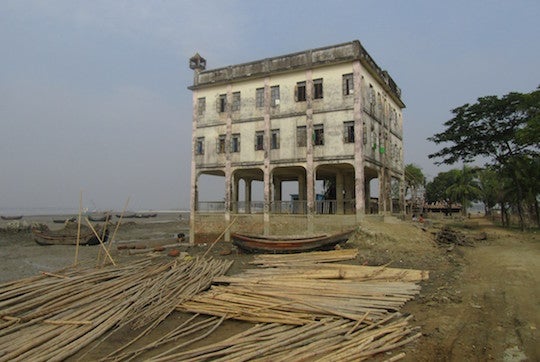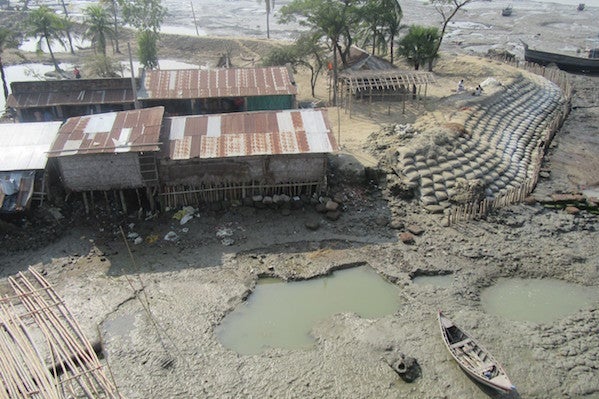This article was published in Scientific American’s former blog network and reflects the views of the author, not necessarily those of Scientific American
In some places, the impact of climate change is obvious. In others, scientists predict that climate change will occur based on elaborate computer models. In Bangladesh, it is already happening at a scale that involves unprecedented human tragedy. I witnessed this in December 2016, when I visited Bangladesh to give some talks at the University of Chittagong.
December 9, 2016.“How do they survive?” I kept wondering as I walked the alleys of Old Dhaka, the capital of Bangladesh, a country with a population of 164 million on a landmass the size of New York State. People seem to be everywhere in Dhaka, in a churning frenzy of rickshaws, CNGs (Compressed Natural Gas vehicles), taxis, buses, horse-drawn carriages and people—16 million and rapidly growing. The newest arrivals, mostly climate change refugees, end up in decrepit slums.

Elementary school, which has doubled as a storm shelter. Credit: Robert Glennon
On supporting science journalism
If you're enjoying this article, consider supporting our award-winning journalism by subscribing. By purchasing a subscription you are helping to ensure the future of impactful stories about the discoveries and ideas shaping our world today.
December 18, 2016. “What will the sea do next,” I thought when I visited the remote village of Premasia, Bangladesh, at the junction of the Sangu River and the Bay of Bengal, south of Chittagong. The schoolchildren greeted us with spontaneous joyfulness, full of hope, despite the visible aftermath of Cyclone Roanu, which struck in May 2016, washing away homes and permanently ruining croplands from salt deposits. Their three-story concrete school, raised on stilts, served as a cyclone shelter during the storm. Isolated palm trees, now surrounded by water and beach, are haunting reminders that here once stood someone’s home. Rising sea levels are turning land into sea bottom, driving some people farther inland. Others rebuild repeatedly, just as Sisyphus kept pushing the rock up the hill.
December 25, 2016. “Bare rock in the high Himalayas?” I gasped as my guide Phuri Kitar Sherpa pointed out Machapuchare, also known as Fish Tail, an immense obelisk of stone perched above Pokhara, Nepal, a jumping off spot for trekkers and alpinists. A third-generation Sherpa guide, Phuri told me he rarely used to see bare stone on this holy site, now off limits to climbing and never summited. Climate change is responsible for a long-term decline in snowpack in the Himalayas, which exacerbates flooding in rivers that flow into Bangladesh.
One of the poorest countries on Earth, Bangladesh has made remarkable strides since gaining its independence in a war with Pakistan in 1971. On December 15, 2016, I met with A.B.M. Fazle Karim Chowdhury, a Member of Parliament, who explained, with a measure of pride, “once there was a shortage of food, now we export food.” Bangladesh once led the world in child mortality. No longer. Due to better health care, life expectancy rose by 10 years, from 59 to 69 between 1990 and 2010. Providing free birth control empowered women and reduced the fertility rate from seven children per woman to three, which is substantially lowering population growth rates. Universal primary education is helping to create a more skilled workforce. Perhaps most impressive, the poverty rate declined from 57 percent to 25 percent between 1990 and 2014. With GNP rates annually hovering around seven percent, MP Chowdhury has reason to proclaim, “We are a developing country. Soon, we’ll be a developed country.”
In December 2016, construction seemed ubiquitous in Dhaka and Chittagong. Even the garment industry, which has a woeful record of protecting workers rights, made painfully obvious by the collapse of a factory in 2013, which killed more than 1,000 workers, shows signs of change. I visited Smart Jeans Ltd. on December 13, 2016. The factory’s bright lights, spotlessly clean floors, and sophisticated air filtration system reminded me more of a hospital in the United States than a sweatshop in a developing country. However, the impact of climate change may overwhelm this progress.
Bangladesh sits at the head of the Bay of Bengal, astride the largest river delta on Earth, formed by the junction of the Brahmaputra, Ganges, and Meghna rivers. Nearly one-quarter of Bangladesh is less than seven feet about sea level; two-thirds of the country is less than 15 feet above sea level. Most Bangladeshis live along coastal areas where alluvial delta soils provide some of the best farmland in the country.
Sea surface temperatures in the shallow Bay of Bengal have significantly increased, which, scientists believe, has caused Bangladesh to suffer some of the fastest recorded sea level rises in the world. Storm surges from more frequent and stronger cyclones push walls of water 50 to 60 miles up the Delta’s rivers.
At the same time, melting of glaciers and snowpack in the Himalayas, which hold the third largest body of snow on Earth, has swollen the rivers that flow into Bangladesh from Tibet, Nepal, Bhutan, and India. So too have India’s water policies. India diverts large quantities of water for irrigation during the dry season and releases most water during the monsoon season.
According to the Bangladesh government’s 2009 Climate Change Strategy and Action Plan, “in an ‘average’ year, approximately one quarter of the country is inundated.” Every four to five years, “there is a severe flood that may cover over 60% of the country.” Rapid erosion of coastal areas has inundated dozens of islands in the Bay. For example, Sandwip Island, near Chittagong, has lost 90 percent of its original 23-square-miles—mostly in the last two decades.
Climate change in Bangladesh has started what may become the largest mass migration in human history. In recent years, riverbank erosion has annually displaced between 50,000 and 200,000 people. The population of what the Bangladesh government calls “immediately threatened” islands, called “chars,” exceeds four million.
The Bangladesh riverine environment is so dynamic that, as chars wash away, the process of accretion creates new chars downstream. Land is so scarce and the population so dense that the displaced people try to eke out an existence on these new, highly unstable sand bars.
A three-foot rise in sea level would submerge almost 20 percent of the entire country and displace more than 30 million people. Some scientists project a five-to-six foot rise by 2100, which would displace perhaps 50 million people. As perspective, the ongoing tragedy in Syria has caused the exodus of approximately three million people.
Already, the intruding sea has contaminated groundwater, which supplies drinking water for coastal regions, and degraded farmland, rendering it less fertile and eventually barren.
It is not just people who are affected. The Sundarbans, the largest mangrove forest in the world and a World Heritage Site, lies in the delta of the Ganges River in Bangladesh and India. Home to the iconic Bengal tiger, the Sundarbans also play a critical role in protecting Bangladesh’s coastal areas from storm surges caused by cyclones.
Nevertheless, across coastal Bangladesh, sea-level rise, exacerbated by the conversion of mangrove forest for agricultural production and shrimp farming, has resulted in the loss of hundreds of thousands of acres of mangroves. In the Sundarbans, the number of tigers has plummeted. The World Wildlife Fund predicts that the tiger may become extinct. Further loss of mangrove habitat, especially in the Sundarbans, also means that Bangladesh will lose one of its last natural defenses against climate change-induced super-cyclones.

Low-tech levee made of sandbags. Credit: Robert Glennon
Engineering adaptations to climate change that have been successful in other nations—such as the dikes constructed in the Netherlands—won’t work in Bangladesh because the soils are sandy and constantly shifting. The government has undertaken measures to adapt to climate change. It has developed an effective early warning system to alert coastal rural areas of impending cyclones; built a network of 2,100 cyclone shelters, which can accommodate more than a million people; and financed 4,000 miles of coastal embankment projects. It is even planting trees on chars in an effort to create islands that are more durable. However, despite its economic progress, Bangladesh remains a poor country with limited resources. Some measures, such as levees made of sand bags along the Bay of Bengal and the Sangu River, may temporarily stem the ocean’s advance, but they offer at best a short-term fix.
These changes are happening to the people of Bangladesh, not caused by them. As a country, Bangladesh emits only 0.3 percent of the emissions producing climate change.
February 16, 2017. “Where will they go?” Climate refugees, mostly rural farmers and fishermen, are moving into the slums of the country’s two largest cities, Dhaka and Chittagong. As conditions deteriorate, the capacity of these areas to absorb more people is nearing the end. The sad reality offers limited options to those displaced. Climate refugees from Bangladesh, a predominantly Muslim country, are not welcome in the neighboring countries of India and Myanmar. India is building its version of a border wall, a barbed-wire fence; violence in Myanmar in December 2016 drove an estimated 65,000 Rohingya, an ethnic Muslim minority, into Bangladesh.
It is exceedingly unlikely that the Trump Administration either will welcome Bangladeshi refugees or provide financial support to underwrite costs of relocation to other countries. Opportunities for resettlement in the rest of the world are dwindling.
The unfolding calamity demands a response from the international community. Wealthy countries have generated most of the greenhouse gases that are harming Bangladesh. If these countries are unwilling to absorb tens of millions of refugees, there is a moral imperative for them to help. They should underwrite the adaptation efforts of the Bangladesh government and the construction of roads, power plants, water supply systems, housing and other infrastructure to allow these climate refugees to remain and thrive in their own country.